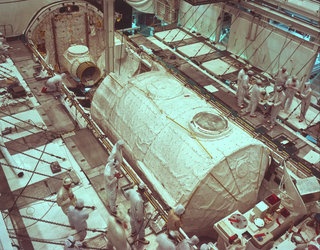Spacelab
Europe’s Spacelab was like a small reusable space station designed to fit in the Space Shuttle’s cargo bay.
Instead of a single piece of hardware, it was a suite of elements: pressurised modules, unpressurised platforms (‘pallets’) and other hardware mixed to create a laboratory each time for a specific mission.
The system had two pressurised laboratory modules with airlocks and optical windows, a tunnel and five separate pallets, which could be mounted separately from the Spacelab and expose experiments to space.

After signing the Spacelab agreement in 1973, the construction of the first components started in Germany in 1974 by ERNO (later part of EADS Space Transportation). The first Spacelab mission, on STS-9, was launched in 1983.
In all, 22 Spacelab missions flew by the programme’s end in 1998.
The pallets, built by British Aerospace, also carried payloads on non-Spacelab flights: the first flew on the second Shuttle mission in 1981 and the last in 2008.
Pressurised module
The outer diameter of the module was 4.12 m, and one segment was 2.7 m long. The long module had two short segments, extending the length to 5.4 m (plus bulkheads on both ends). The short-segment version was never used.
Two modules were built; the second is displayed at Bremen airport in Germany.
Pallet

The pallet was a U-shaped platform for mounting instrumentation and experiments in the Shuttle cargo bay, with or without the pressurised module.
It was possible to have up to five pallets at one flight, capable of carrying more than nine tonnes of payload.
One of the pallets is now displayed at the Swiss Museum of Transport in Lucerne.
Igloo

The pressurised ‘igloo’ housed the systems needed to operate the Spacelab equipment when a pressurised module was not flown. Two units, about 3 m high and 1.5 m in diameter, were built by SABCA in Belgium.
Other components
Other major Spacelab elements include the Instrument Pointing System for sensors needing precise pointing, and a tunnel connecting the pressurised module to the Shuttle cabin.
Download a more detailed description of Spacelab here (pdf).















 Germany
Germany
 Austria
Austria
 Belgium
Belgium
 Denmark
Denmark
 Spain
Spain
 Estonia
Estonia
 Finland
Finland
 France
France
 Greece
Greece
 Hungary
Hungary
 Ireland
Ireland
 Italy
Italy
 Luxembourg
Luxembourg
 Norway
Norway
 The Netherlands
The Netherlands
 Poland
Poland
 Portugal
Portugal
 Czechia
Czechia
 Romania
Romania
 United Kingdom
United Kingdom
 Slovenia
Slovenia
 Sweden
Sweden
 Switzerland
Switzerland































